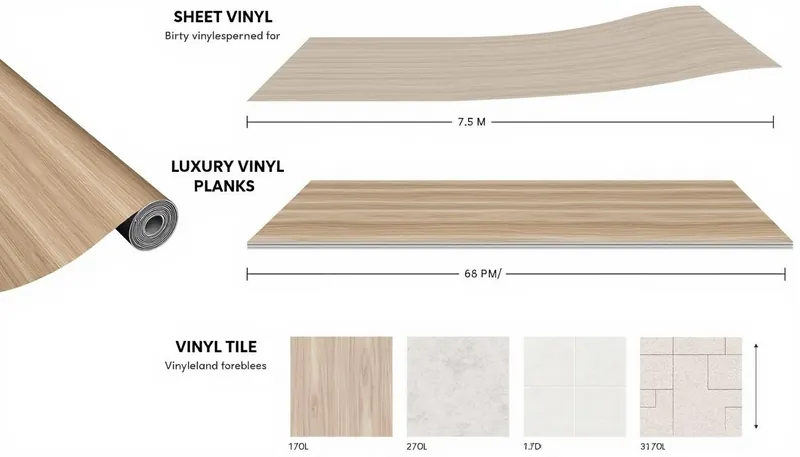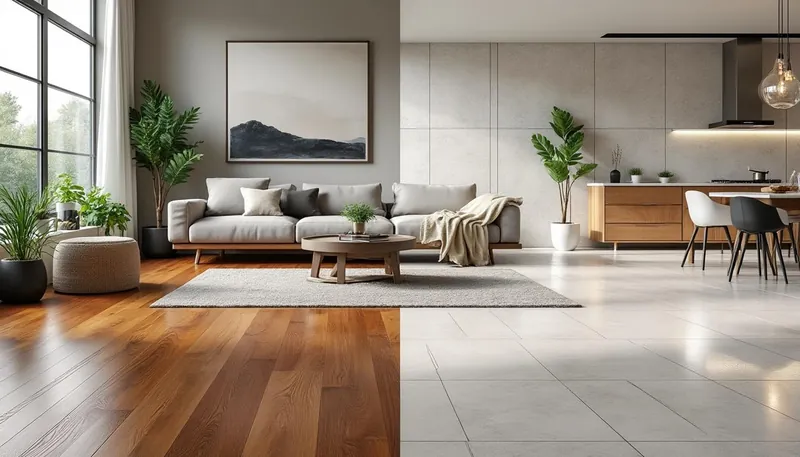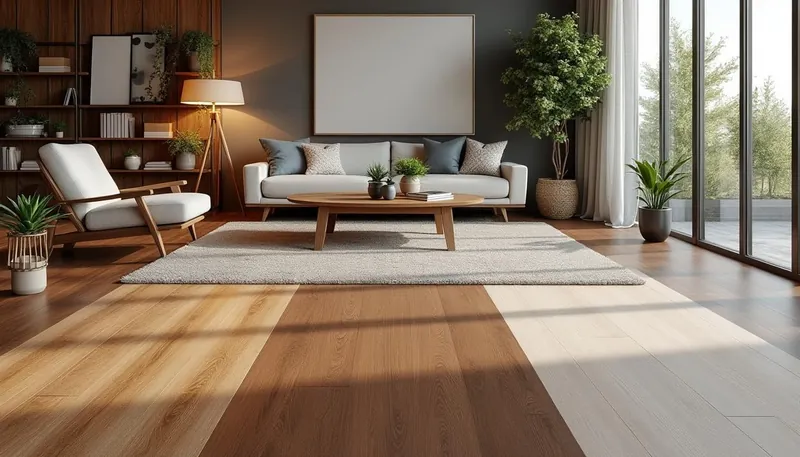When diving into the world of flooring options, two materials often make their way to the top of the list: laminate and vinyl. As homeowners embrace stylish, budget-friendly, and durable flooring solutions, understanding the nuances between these two popular choices becomes imperative. In 2025, homeowners are increasingly focused on both aesthetics and functionality when renovating their spaces. With the rapid advancements in technology and design, laminate and vinyl flooring have been transformed into attractive alternatives to traditional hardwood. However, what are the key differences that’ll help you decide which one is perfect for your home? This article explores the intricacies of laminate and vinyl flooring, showcasing their construction, advantages, limitations, and ideal uses within American homes.
Brief
- 💧 Water Resistance: Vinyl flooring is often 100% waterproof, while laminate is moderate and not ideal for wet areas.
- 🛡️ Durability: Vinyl fights stains and moisture better than laminate and is perfect for busy households.
- 🔍 Design Variety: Both present stylish options, but vinyl takes the lead with realistic looks of wood, stone, and more.
- 🛠️ Installation: DIY-friendly options are plentiful for both, but installation techniques vary significantly.
- 💰 Cost: Laminate tends to be more budget-friendly than vinyl, though higher-end options exist for both.
Understanding Laminate Flooring: Construction and Benefits
Laminate flooring has garnered attention among budget-conscious homeowners in recent years. It’s crafted from high-density fiberboard and consists of several layers, culminating in a product that not only looks great but also holds up well under daily wear. The layers include a clear protective wear layer, a photographic design layer that beautifully mimics hardwood or stone, a core layer that provides strength, and a backing layer that creates additional stability and moisture protection.

Advantages of Laminate Flooring
Using laminate flooring comes with numerous advantages:
- 💰 Cost-Effectiveness: Compared to solid hardwood, laminate offers an affordable way to achieve a similar aesthetic at a fraction of the price.
- 🛡️ Scratch & Fade Resistance: Thanks to its tough wear layer, it resists scratches and fading remarkably well, making it suitable for homes with pets.
- 🛠️ Easy Installation: With a click-lock system, laminate can be installed by savvy DIYers without the need for adhesives.
- 🌈 Variety of Designs: Modern laminate options include a wide range of realistic wood, stone, and tile looks, catering to diverse design preferences.
While ideal for living rooms and bedrooms, laminate isn’t the best fit for moisture-heavy areas, which leads us to its limitations.
Limitations of Laminate Flooring
As strong as laminate flooring is, it does come with drawbacks:
- 🚫 Moisture Sensitivity: Exposed to excessive moisture, it can swell and become damaged.
- ⚠️ Non-Refinishable: Once scratched or damaged, laminate cannot be refinished like hardwood; replacement is the only option.
- 🔊 Sound: Its firmer surface may echo or sound hollow unless a quality underlayment is added.
| Feature | Laminate Flooring |
|---|---|
| Water Resistance | Moderate |
| Durability | Scratch-resistant |
| Installation | Click-lock, DIY-friendly |
| Comfort Level | Firm underfoot |
| Cost ($/sq.ft) | $1.00–$5.00 |
Understanding Vinyl Flooring: Construction, Types, and Advantages
Vinyl flooring has evolved significantly, providing various attractive options, including sheet vinyl, luxury vinyl planks (LVP), and luxury vinyl tiles (LVT). This material is entirely synthetic, composed of multiple layers that offer comfort, resilience, and most importantly, excellent water resistance. Particularly popular in moisture-prone areas, vinyl has become the go-to choice for contemporary home designs.

Types of Vinyl Flooring
Here’s a breakdown of the common types in 2025:
- 🛡️ Sheet Vinyl: Continuous sheets ideal for moisture-heavy spaces like bathrooms.
- 🌳 Luxury Vinyl Plank (LVP): Designed to look like hardwood, offering realistic textures.
- 🧊 Luxury Vinyl Tile (LVT): Mimics stone or ceramic tile beautifully, offering versatile design options.
Advantages of Vinyl Flooring
Opting for vinyl comes with its own list of benefits:
- 💧 Waterproof: Essential for kitchens, bathrooms, and laundry rooms where spills are common.
- 🙌 Durability: Scratch and stain-resistant, making it ideal for families and pets.
- 🔉 Comfort: Softer underfoot compared to laminate, it provides a quieter experience.
- ⭐ Design Options: A wide selection of realistic designs makes it easy to find a perfect match for any decor.
| Feature | Vinyl Flooring |
|---|---|
| Water Resistance | Excellent |
| Durability | Highly durable |
| Installation | Click-lock, glue-down, DIY |
| Comfort Level | Softer, quieter |
| Cost ($/sq.ft) | $2.00–$7.00 |
Comparing Durability and Longevity: Laminate vs. Vinyl
When it comes to durability, some homeowners might find themselves wondering which option stands the test of time better. Both laminate and vinyl are designed to endure foot traffic, but they tackle wear and tear differently.
Scratch and Dent Resistance
Both products appear sturdy; however, laminate’s wear layer typically offers great scratch resistance while vinyl’s surface is more resilient to indentations caused by heavy objects. In high-traffic scenarios, vinyl proves itself as a solid contender.
Moisture Resistance: The Key Distinction
Moisture is where the difference becomes pronounced. Standard laminate has some level of resistance, but it’s not entirely water-proof. On the other hand, vinyl flooring is naturally waterproof, making it the star choice for wet areas.
Comfort and Acoustics Underfoot
Another angle when considering flooring material is the comfort it provides. Laminate, with its rigid design, can feel hard and echo, while vinyl tends to provide a softer, quieter feel, making it ideal especially in upper-level rooms.
Installation Processes: Laminate vs. Vinyl
The installation process can significantly impact the overall experience for homeowners. Both types of flooring have their unique installation requirements that cater to different skill levels.
Laminate Installation
Laminate installation is typically known for being DIY-friendly, utilizing a click-lock system that allows planks to be snapped together. Here’s a breakdown of the steps involved:
- 🔨 Prepare the Subfloor: Ensure it’s clean and dry.
- 🧱 Lay Down Underlayment: Important for leveling and sound dampening.
- 👷 Snap Planks Together: Follow the staggered pattern for aesthetics.
- ✔️ Add Transition Strips: Important for doorways and high-traffic areas.
Vinyl Installation
Vinyl flooring boasts multiple installation options. Here’s what to keep in mind:
- 🖋️ Click-Lock Planks: Ideal for DIYers and easy to work with.
- 🔗 Glue-Down Options: Best suited for commercial spaces or high-traffic areas.
- 🌀 Loose Lay: Heavy enough to stay in place without adhesives, speeding installation.
Vinyl also typically skips the acclimation steps, streamlining the process further.
| Installation Method | Laminate | Vinyl |
|---|---|---|
| DIY Friendliness | High | High |
| Preparation Required | Minimal | Minimal |
| Acclimation | Needed | Not needed |
| Common Tools Needed | Utility knife, saw | Utility knife, adhesive options |
Cleaning and Maintenance: How They Stack Up
With busy lifestyles, maintenance often dictates the choice between two flooring types. Here’s what to note about caring for laminate and vinyl:
Maintenance for Laminate Flooring
- 🧹 Regular Cleaning: Sweep or vacuum to remove dirt and debris.
- 💧 Mopping: Use a damp cloth with approved cleaners; avoid excess water.
- 🚫 Prevent Damage: Avoid harsh chemicals that could harm the surface.
Maintenance for Vinyl Flooring
- 🧼 Low Maintenance: Routine sweeping and occasional mopping suffice.
- 💦 Water Resistance: Spills can be cleaned easily without damaging the flooring.
- ❌ No Waxing Required: Vinyl doesn’t need waxing or polishing.
| Type | Laminate Maintenance | Vinyl Maintenance |
|---|---|---|
| Cleaning Frequency | Regular | Routine |
| Necessary Supplies | Laminate-safe cleaners | Mild cleaners or soap |
| Water Sensitivity | Sensitive | Waterproof |
Can laminate and vinyl flooring be installed over existing floors?
Yes, both types can often be placed over existing hard surfaces, provided they are clean and flat.
Which flooring adds more value to a home?
High-quality luxury vinyl often appeals to buyers due to its aesthetics and waterproof features, while laminate may provide a modest boost in value.
What’s better for homes with pets?
Vinyl generally dominates with its robust waterproof qualities and easy maintenance.
Are laminate and vinyl environmentally friendly?
Laminate can be more eco-friendly if sourced sustainably, while vinyl, being petroleum-based, has more limited options.


